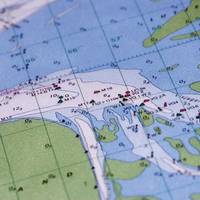IMO Reviews GMDSS Requirements
International Maritime Organization (IMO)'s Sub-Committee on Navigation, Communications and Search and Rescue (NCSR) said that it will continue its ongoing work to review GMDSS requirements, to enable the use of modern communication systems in the Global Maritime Distress and Safety System (GMDSS), while removing requirements to carry obsolete systems.Search and rescue at sea depends on the integrated satellite and terrestrial radio-communication communications system - the GMDSS. The GMDSS is mandatory under the International convention for the Safety of Life at Sea (SOLAS).According to the Sub-Committee, the aim is to finalize the review in 2021, for submission to the Maritime Safety Committee (MSC), so that SOLAS amendments can be adopted for entry into force in 2024.
The USCG RDC & Electronic Aids To Navigation

To recreational boaters, Aids to Navigation (ATON) are the familiar red and green buoys (and day markers) that line our inland waterways. What they might not be aware of is that buoys have been around since the days of the Roman and Egyptian empires. In the decades following the creation of our country, buoys in every shape and color began appearing in our waterways. It wasn’t until 1850 that Congress harmonized their deployment, thereby encouraging the familiar “Red, Right, Returning” mantra.
NSA Chief Urges 'Safe' Internet Under Equivalent of Law of the Sea
The U.S. National Security Agency chief called on Wednesday for an "open, reliable and safe" Internet governed by international rules akin to the Law of the Sea, while deflecting critics who say NSA spying has undermined public trust in the cyberworld. Admiral Michael Rogers spoke a few days after the U.S. Senate rejected a bill to extend spy agencies' bulk collection of Americans' telephone records, putting the programme in doubt shortly before its expiry on June 1. Addressing a cyberwarfare conference in Estonia, Rogers adopted the diplomatic language of a grassroots online governance activist, hailing the Internet's openness and value as a shared, public good.
Global Shipping Exposed to Cyber Threats

The next hacker playground: the open seas - and the oil tankers and container vessels that ship 90 percent of the goods moved around the planet. In this internet age, as more devices are hooked up online, so they become more vulnerable to attack. As industries like maritime and energy connect ships, containers and rigs to computer networks, they expose weaknesses that hackers can exploit. Hackers recently shut down a floating oil rig by tilting it, while another rig was so riddled with computer malware that it took 19 days to make it seaworthy again…
RADAR vs MOBILE PHONE

2% (or $1.3 trillion)* of World GDP is accounted for by the mobile telecommunications industry. By comparison, the minute fraction of this that the marine radar industry accounts for has probably not been discovered yet. So what chance does radar have against such overwhelming authority, or should we say, financial might? Marine radar operates in two main frequency bandwidths, 3GHz and 9GHz. The mobile phone and wi-fi industries also like the 3GHz arena, and have their frequency allocations virtually adjacent to our very own S-Band radar, and therein lies the problem.
AIS: The Future is Now
The IMO deadline for fitting new ships with Automatic Identification Systems (AIS) is less than one year away. After July 1, 2002, all newbuilds over 300 grt must be equipped with an approved AIS transponder system. Leica Geosystems, one of the pioneering companies in AIS technology, recently published a 28-page book ("A Complete Guide to Automatic Identification Systems") that is loaded with useful information on AIS technology, how it works, international standards and carriage requirements. At the Norshipping exhibition in Oslo, Leica unveiled the first fully integrated GPS/DGPS/AIS shipboard system meeting all IMO, IEC and ITU equipment specifications. The following extracts are reprinted with permission from Leica Geosystems. What is AIS?
AIS - Panacea or Pandora's Box
According to Greek legend, Zeus had the messenger god Mercury leave a mysterious box with Pandora. Mercury told Pandora to hold the box for safe-keeping, but under no circumstances was she to open it. Not long after Mercury departed, curiosity got the better of Pandora and she opened the box to examine its contents. Unfortunately, the box contained all the ills and misfortunes of the world. They promptly escaped and have been loose in the world since that time. The word 'panacea' is derived from the Greek terms "pan" (meaning all) and "akos" (meaning remedy). The question is which term applies to AIS? What is AIS? AIS is an electronic transceiver unit intended to be integrated with a ship's radar, gyrocompass, global positioning system (GPS), and other operational and navigational systems.
Northrop Grumman Receives QinetiQ Type Approval
Northrop Grumman Corporation's Sperry Marine business unit today announced that its BridgeMaster E marine radars have been certified by QinetiQ (formerly DERA) to meet the new international regulations for radio frequency emissions. The International Telecommunications Union this year adopted new requirements radically tightening the amount of permissible spurious and out-of-band emissions that can be emitted by marine radars. The new specifications become effective Jan. 1, 2003, and all new radars installed after that date must be certified to meet the new requirements. The QinetiQ type approvals apply to all Sperry Marine's BridgeMaster E X- and S-Band radar systems, as well as Sperry Marine's MK 6217/9 TFT River Radar.









